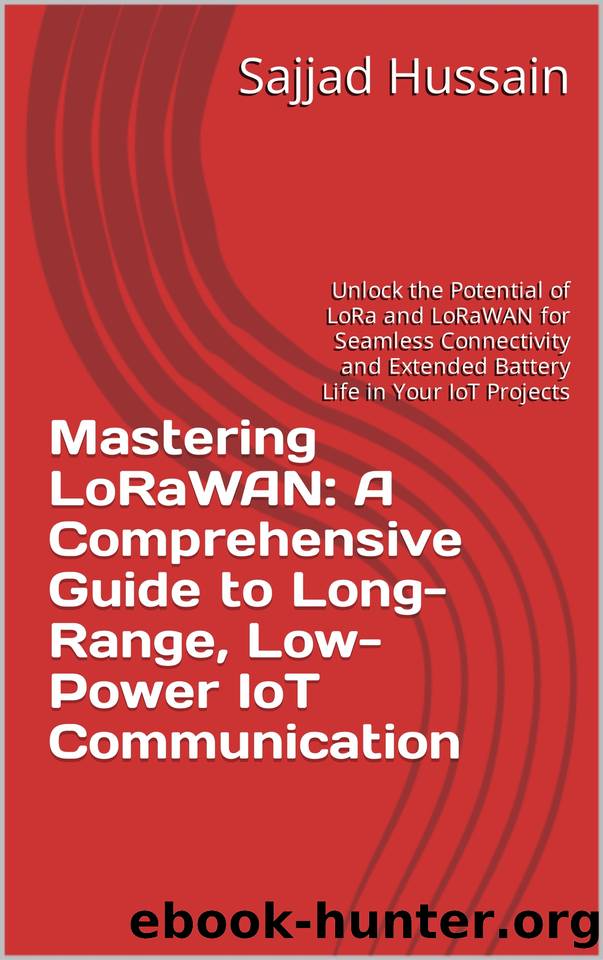Mastering LoRaWAN: A Comprehensive Guide to Long-Range, Low-Power IoT Communication: Unlock the Potential of LoRa and LoRaWAN for Seamless Connectivity and Extended Battery Life in Your IoT Projects by Sajjad Hussain

Author:Sajjad Hussain [Hussain, Sajjad]
Language: eng
Format: epub
Published: 2024-01-30T00:00:00+00:00
Selecting the appropriate gateway device is vital for LoRaWAN deployment. The gateway serves as the bridge between the end-node devices and the network server. It is responsible for receiving data transmissions from end-nodes and relaying them to the server. Coverage is a fundamental consideration when choosing a gateway. By analyzing the geographical area to be covered and estimating the number of end-nodes, a gateway with high sensitivity and a wide communication range can be selected to ensure reliable connectivity across the network.
Connectivity is another critical factor to contemplate. LoRaWAN supports both indoor and outdoor gateway deployments. For indoor deployments, gateway devices with Ethernet or Wi-Fi connectivity options are suitable. In contrast, outdoor deployments may necessitate cellular or satellite connectivity to establish a consistent link with the network server. It is essential to carefully evaluate the network coverage options available in the target area to make informed decisions regarding gateway connectivity.
Secondly, the selection of end-node devices should be based on various factors, including power consumption and form factor. To ensure long battery life, end-nodes should possess low power consumption capabilities. This becomes crucial when deploying sensors on remote or inaccessible sites, where frequent battery replacement or recharging becomes impractical. Therefore, choosing end-nodes that can operate on ultra-low power modes and utilize energy-efficient communication protocols is vital for a sustainable LoRaWAN deployment.
Similarly, the form factor of end-node devices directly impacts their versatility and adaptability to diverse IoT applications. Depending on the use case, end-nodes must accommodate physical constraints while providing desired functionality. For instance, industrial applications may require ruggedized end-node devices that can withstand harsh environmental conditions. Conversely, wearable devices for healthcare applications should be compact, lightweight, and unobtrusive. It is essential to explore end-node options that align with specific application requirements and usability preferences.
Scalability is another critical aspect that should be considered when choosing end-node devices. The LoRaWAN network must be adaptable to expansion and accommodate an increasing number of end-nodes. Therefore, end-node devices should be compatible with interoperable connectivity, ensuring seamless integration with existing gateways and network infrastructure. By choosing scalable end-node devices, network administrators can easily expand the network without facing compatibility issues or excessive investments.
Moreover, the security of LoRaWAN networks cannot be overlooked when selecting gateway and end-node devices. As IoT devices are prone to potential vulnerabilities, it is essential to choose devices with built-in security features. Gateways equipped with advanced encryption methods, secure boot mechanisms, and secure firmware updates provide a robust defense against potential threats. Similarly, end-node devices should implement secure authentication and encryption protocols to protect sensitive data from unauthorized access or tampering.
Considering the ecosystem around LoRaWAN is also crucial. As LoRaWAN technology continues to evolve, it is beneficial to choose devices from reputable vendors that show commitment to ongoing product development, support, and updates. Vendors that actively participate in the LoRa Alliance, a non-profit organization responsible for developing and promoting LoRaWAN, contribute to the growth and standardization of the technology. By selecting such devices, network administrators can ensure compatibility with future enhancements and avail themselves of new features as they become available.
Download
This site does not store any files on its server. We only index and link to content provided by other sites. Please contact the content providers to delete copyright contents if any and email us, we'll remove relevant links or contents immediately.
Optimizing Microsoft Azure Workloads by Rithin Skaria(7065)
Kubernetes in Production Best Practices by Aly Saleh and Murat Karslioglu(6808)
Cloud Computing Demystified for Aspiring Professionals by David Santana(5946)
Zed Attack Proxy Cookbook by Ryan Soper & Nestor N Torres & Ahmed Almoailu(5377)
Google Cloud for Developers: Write, migrate, and extend your code by leveraging Google Cloud by Hector Parra Martinez(3978)
AWS Observability Handbook by Phani Kumar Lingamallu & Fabio Braga de Oliveira(3606)
Mastering Cyber Intelligence by Jean Nestor M. Dahj;(3353)
The Road to Azure Cost Governance by Paola E. Annis Giuliano Caglio(2856)
Microsoft 365 Fundamentals Guide by Gustavo Moraes and Douglas Romão(2297)
Cloud Identity Patterns and Strategies: Design enterprise cloud identity models with OAuth 2.0 and Azure Active Directory by Giuseppe Di Federico Fabrizio Barcaroli(2204)
Agile Security Operations: Engineering for Agility in Cyber Defense, Detection, and Response by Hinne Hettema(2175)
Bootstrapping Service Mesh Implementations with Istio by Anand Rai(2083)
The Road to Azure Cost Governance: Techniques to tame your monthly Azure bill with a continuous optimization journey for your apps by Paola E. Annis Giuliano Caglio(1331)
Agile Security Operations: Engineering for agility in cyber defense, detection, and response by Hinne Hettema(1251)
Zed Attack Proxy Cookbook: Hacking tactics, techniques, and procedures for testing web applications and APIs by Ryan Soper Nestor N Torres Ahmed Almoailu(1247)
Information security 05-2024 by Unknown(1188)
Linux Administration Best Practices: Practical Solutions to Approaching the Design and Management of Linux Systems by Scott Alan Miller(1179)
DevSecOps in Practice with VMware Tanzu: Build, run, and manage secure multi-cloud apps at scale on Kubernetes with the Tanzu portfolio by Parth Pandit Robert Hardt(1127)
Terraform for Google Cloud Essential Guide by Bernd Nordhausen(973)
